Gomti Ghat in Dwarka feels like a gentle pause in time, where the Gomti River kisses the Arabian Sea. Just steps from the Dwarkadhish Temple, this holy ghat hums with pilgrims, prayers, and the soft lapping of waves. Its stone steps, small shrines, and salty breeze create a place where faith and nature meet. Whether you’re dipping in the sacred Gomti Kund, floating diyas at sunset, or watching kids chase waves, the ghat offers peace and stories.
Why Gomti Ghat Feels So Special
Gomti Ghat, tucked behind Dwarka’s Dwarkadhish Temple, is a sacred gem that warms your heart. The Gomti River, believed to be Ganga’s daughter, meets the Arabian Sea here, making every dip a cleansing ritual. Pilgrims bathe at Gomti Kund, where the river and sea blend, seeking blessings. The ghat’s 56 steps lead to small temples for Krishna, Shiva, and Sudama, buzzing with chants. At sunset, floating diyas light up the water, creating a magical glow. Despite some litter, as noted on Tripadvisor, the ghat’s vibe stays serene. Locals sell seashell trinkets, and kids somersault into waves, adding lively charm. The Sudama Setu bridge offers stunning views, perfect for photos. Whether you’re praying or just soaking in the scene, Gomti Ghat feels like a sacred hug, blending Dwarka’s spiritual pulse with the sea’s endless rhythm.
The History and Myths of Gomti Ghat
Gomti Ghat’s story stretches back to ancient times, woven with myths of Lord Krishna. Hindu tales say the Gomti River, daughter of Sage Vashishta, was brought to Dwarka by Krishna to purify his golden city. At Gomti Kund, where the river meets the sea, Krishna is said to have served Sage Durvasa, adding sacred weight. The ghat, near the Dwarkadhish Temple, has been a pilgrimage spot for centuries, with texts like the Puranas praising its sin-cleansing waters. Mughal and local rulers built stone ghats over time, though exact dates are fuzzy. The nearby Samudra Narayana Temple marks the river-sea confluence, tying it to Vishnu. Despite wear from tides and crowds, the ghat stands as a timeless link to Dwarka’s Krishna legends, where every wave carries a story of faith and devotion that pilgrims still chase today.
Things to Do at Gomti Ghat
Gomti Ghat is a lively mix of faith and fun. Start with a dip in Gomti Kund, believed to wash away sins—hold the iron chains for safety, as waves can be strong. Visit tiny shrines to Krishna, Rama, or Gomti Mataji for quick prayers. Floating diyas (Rs. 10) at evening aarti is a glowing ritual, especially during Janmashtami. Walk the Sudama Setu bridge for panoramic views or take a boat ride (Rs. 50-100) to see Dwarka’s coast. Feed fish with atta dumplings or cows for blessings, as locals suggest. Small stalls sell seashell jewelry, great for souvenirs. The ghat’s vibe, with kids splashing and pilgrims chanting, feels joyful, though Tripadvisor notes slippery spots. Whether you’re meditating, snapping photos of the sunset, or soaking in the spiritual air, Gomti Ghat keeps you wrapped in Dwarka’s sacred charm.
Joining the Evening Aarti
The evening aarti at Gomti Ghat is a soulful moment. Around 6:30 PM, priests light diyas and chant by the Gomti Kund, their voices mingling with the sea’s hum. Pilgrims join in, floating tiny lamps that dance on the water, creating a golden glow. It’s free, but arrive by 6:00 PM for a good spot, as it gets crowded. Wear modest clothes—sarees or kurtas—and watch for slippery steps, as Tripadvisor warns. The 20-minute ritual feels sacred, tying you to Dwarka’s Krishna legends. Buy diyas from stalls (Rs. 10-20) and offer a small donation (Rs. 20) to support the ghat. During festivals like Janmashtami, the aarti sparkles with extra lights. This shared prayer, with waves and chants, leaves you calm and connected, a memory that lingers long after the lamps fade.
Exploring Nearby Temples
Gomti Ghat is dotted with small temples that add to its charm. The Gomti Mataji shrine, honoring the river goddess, is a quiet spot for prayers. Nearby, the Samudra Narayana Temple, at the river-sea confluence, has a striking Vishnu statue. Shrines to Shiva, Rama, and Sudama line the ghat, each with simple idols and bells. The Panchanada Tirtha, with five sweet-water wells amid salty sea, is a quirky stop, though hard to access at night. These spots, reachable by a short walk or boat, feel sacred yet welcoming. Entry is free, but donations (Rs. 20-50) help upkeep. Visit in the morning for calm, as evenings get busy. These temples weave Dwarka’s Krishna stories into every step, making your ghat visit a deeper dive into faith.
Planning Your Visit to Gomti Ghat
Gomti Ghat is easy to reach and open 24/7, free to visit. Just 3 km from Dwarka Railway Station, it’s a 10-minute walk from Dwarkadhish Temple’s back gate. Autos from the station cost Rs. 100, or walk via the temple’s Swarga Dwar. Jamnagar Airport (130 km) is the closest, with taxis at Rs. 2000. October to March offers cool weather, ideal for visits, while summers hit 42°C. Stay near the ghat at hotels like Hotel Raj Palace (Rs. 1000-3000). Wear modest clothes, carry cash (Rs. 100-500) for boats or stalls, and watch for slippery steps, as Tripadvisor notes. Early mornings or late evenings are best for fewer crowds and stunning views. With these tips, your trip will be smooth, letting you soak in the ghat’s spiritual and scenic beauty.
How to Get There
Gomti Ghat is a quick hop from Dwarka’s center. From Dwarka Railway Station (3 km), take an auto (Rs. 100) or cycle rickshaw (Rs. 50) to Dwarkadhish Temple, then walk 56 steps down from its Swarga Dwar. Buses from Rajkot (225 km) or Ahmedabad (440 km) drop at Dwarka’s bus stand, 2 km away (Rs. 20 by auto). Driving via NH947 is scenic, with parking at Rs. 20 near the temple. From Jamnagar Airport (130 km), taxis take 2 hours. The ghat is walkable from most Dwarka hotels. Mornings avoid traffic, and Google Maps or locals can guide you. The short journey, with temple views and sea breeze, feels like a warm-up for the ghat’s serene embrace, setting the mood for a peaceful visit.
Nearby Attractions
Gomti Ghat pairs well with Dwarka’s treasures. Dwarkadhish Temple (200 meters) stuns with its 78-meter spire and Krishna idol. Rukmini Devi Mandir (2 km) is a quiet shrine to Krishna’s queen. Bhadkeshwar Mahadev Temple (1 km) sits on a sea rock, perfect for sunset photos. Beyt Dwarka (30 km by ferry) offers Krishna’s island home and coral views. Autos to these cost Rs. 50-200. Try local snacks like fafda near the temple. These spots mix faith, history, and coastal charm, making a day trip from Gomti Ghat a rich blend of Dwarka’s Krishna legacy and scenic beauty, leaving you with a full heart.
Tips for a Great Visit
To make your Gomti Ghat visit shine, plan smart. Wear modest clothes—full pants or sarees—and sturdy shoes for slippery steps, as Tripadvisor mentions. Arrive by 6:00 PM for the aarti or early morning for calm and high tides. Respect rituals—stay quiet during prayers and don’t litter. Carry cash (Rs. 100-500) for diyas, boats, or snacks, as cards are rare. Hold chains while bathing, as waves can be strong. Buy seashell trinkets from locals but haggle gently. Check Janmashtami dates for festive vibes, but book hotels early. Boats to Panchanada Tirtha are fun but confirm prices (Rs. 50-100). Stay hydrated, watch belongings in crowds, and chat with priests for Krishna tales. With these tips, you’ll leave Gomti Ghat with a heart full of peace and memories of Dwarka’s sacred shores.



